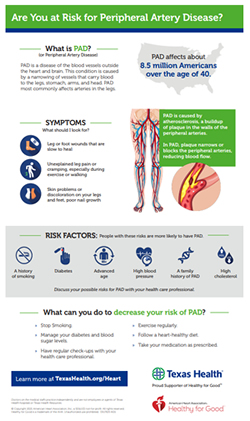Texas Health is proud to join the American Heart Association in the fight against heart disease as the North Texas Go Red for Women® Cause Sponsor. Our involvement with the American Heart Association provides a platform to help educate women on heart health awareness.
If you’re striving to have a healthy heart, it’s important to understand the role your arteries play in overall cardiovascular wellness. Keeping these vessels functioning properly is important because artery disease is a widespread condition that can lead to multiple serious diseases.
When all is going well, your arteries carry oxygen-rich blood supply to different parts of your body. When your arteries get damaged or are narrowed, they have less space for blood to flow. This causes chest pain, shortness of breath and other symptoms.
“Texas Health can help you fight artery disease at every stage,” says Dr. Kami Banks, a cardiologist with Texas Health Heart & Vascular Specialists, a Texas Health Physicians Group practice. “The encouraging news is many of these conditions can be treated or managed.”
“Our best practice is to take things that are in our control and attack them as aggressively as possible,” Banks adds. “I talk about lifestyle factors with every patient at every visit. Everyone has something they can do a little bit better.”
If you are a smoker, quitting smoking is the most critical change you can make to improve the condition of your arteries, according to Banks. Other lifestyle factors include regular exercise, eating a diet low in saturated fat, managing diabetes and reducing stress. In addition, Banks advises you should know your numbers — such as blood pressure, cholesterol and weight — and work to get them to normal levels to help combat artery disease.
“Knowing your numbers is like wearing a seatbelt,” Banks says. “Wearing a seatbelt doesn’t mean you won’t get into a car accident, but it does reduce your risk of being seriously injured. Staying aware of and improving your numbers does the same thing. It reduces the risk.”
If these risks aren’t managed, artery disease may occur. Some common types include:
Coronary artery disease (CAD): This is the most common heart disease in the U.S. according to the Centers for Disease Control and Prevention. Coronary arteries carry blood to the heart and other parts of the body. Disease in these arteries is what leads to heart attacks. Symptoms can include pain in the shoulders, arms and chest. Sometimes there are no symptoms with CAD until the heart attack occurs.
Peripheral artery disease (PAD): Peripheral arteries carry blood away from the heart to the outer regions of the body, including the legs, stomach, arms and head. PAD happens when these arteries narrow, reducing blood flow. It most commonly affects arteries in the legs. PAD increases your risk of coronary artery disease, heart attack and stroke. The most common symptoms are pain, cramping, or tiredness in the legs or hips when walking.
Carotid artery disease: Carotid arteries are located on each side of the neck. They supply the brain and head with blood. A blockage in the carotid arteries increases risk for stroke. Symptoms of stroke include facial droop, difficulty speaking and weakness on one side of the body.
Aortic aneurysm: The aorta is the body’s main artery that carries blood from the heart through the chest and torso. Banks describes the aorta as a “tree trunk structure of vessels in the body.” An aortic aneurysm is a condition in which the aorta is enlarged. There are usually no symptoms unless the aneurysm ruptures. If that happens, symptoms include sudden, intense and persistent abdominal or back pain (often described as a tearing sensation); low blood pressure and a fast pulse.
Factors to Consider
The most common cause of artery disease is atherosclerosis, a hardening of the arteries caused when cholesterol-laden plaque attaches to the inner lining of a blood vessel. Over time, this continued buildup leads to obstruction of blood flow or dilation of the artery, Banks explains.
Atherosclerosis is a slow, lifelong process that may start as early as childhood and progress with aging, according to the American Heart Association. Atherosclerosis is often seen in people who smoke; have high blood pressure; or have high levels of glucose, fat and cholesterol in their blood. Others at risk of developing artery disease include those with a family history and those with diabetes.
“Some inheritable conditions affect an individual’s chance of artery integrity issues or atherosclerosis risk factors, but lifestyle factors account for the majority of risk for artery conditions,” Banks says.
If targeting lifestyle factors doesn’t improve the problem, other treatments may be needed depending on the condition of the arteries and type of disease present, Banks notes. These may include drugs such as aspirin to prevent blood clots or cholesterol medication that reduces plaque formation and rupture. Statins are often recommended to reduce cholesterol and have been directly associated with reducing risk for heart attack and stroke. Sometimes procedures such as stenting to open arteries or surgery to bypass diseased arteries is necessary.
To determine abnormalities and the overall condition of the arteries, doctors may suggest common tests such as an electrocardiogram, echocardiogram, or stress test. However, Banks says, your own intuition is the first line of defense for taking care of artery disease or any other heart-related problem.
“If you have a symptom that concerns you, especially if it’s discomfort in your chest or shortness of breath then seek advice from a medical professional,” she urges. “Don’t wait until you have ‘typical’ symptoms. Some people never get typical symptoms of coronary artery disease. Doctors know the medicine and you know your body.”
Comprehensive Care across North Texas
Banks says the options provided across the Texas Health system set them apart from others. “You’re getting a team with a connected network of cardiologists and cardiovascular specialists that can provide you the most up-to-date care.”
She adds that Texas Health is a desirable place to be a patient because of its connection to UT Southwestern Medical Center, which is a top research and training facility. In fact, it is this affiliation that Banks says attracted her to practice within Texas Health.
“That relationship is huge to me and it should be for patients as well,” she says. “This partnership provides the advantage of having the reach and clinical expertise of Texas Health backed by the academic power and research of UT Southwestern. Together, this is powerful.”
If you suspect you have symptoms of artery disease, find a heart and vascular specialist today or visit TexasHealth.org/Heart.
Texas Health Physicians Group providers are employed by Texas Health Physicians Group and are not employees or agents of Texas Health Resources hospitals.
Doctors on the medical staffs practice independently and are not employees or agents of Texas Health hospitals or Texas Health Resources.


